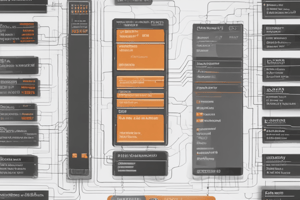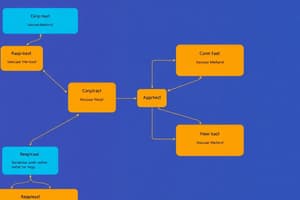Podcast
Questions and Answers
What do System Sequence Diagrams (SSDs) show?
What do System Sequence Diagrams (SSDs) show?
- Complex system behaviors
- The internal structure of the system
- Interactions between actors and the system
- Inputs and outputs for each use case as messages (correct)
What is the purpose of a Domain Model?
What is the purpose of a Domain Model?
- To model how problem domain classes and use cases interact (correct)
- To visualize system sequence diagrams
- To show the internal structure of the system
- To represent the interactions between actors and the system
What is the role of actors in System Sequence Diagrams?
What is the role of actors in System Sequence Diagrams?
- Actors are entities external to the system and initiate actions that the system responds to (correct)
- Actors are part of the system and control its behavior
- Actors are responsible for modeling system behaviors
- Actors are not relevant in System Sequence Diagrams
When should use cases be modelled in detail according to the text?
When should use cases be modelled in detail according to the text?
What type of diagram is a System Sequence Diagram (SSD)?
What type of diagram is a System Sequence Diagram (SSD)?
What do System Sequence Diagrams provide a clear visual representation of?
What do System Sequence Diagrams provide a clear visual representation of?
What does CRUD analysis correlate according to the text?
What does CRUD analysis correlate according to the text?
What did the Domain Model not model according to the text?
What did the Domain Model not model according to the text?
What is the representation of actors and the system in System Sequence Diagrams?
What is the representation of actors and the system in System Sequence Diagrams?
What type of diagram do System Sequence Diagrams use?
What type of diagram do System Sequence Diagrams use?
What is the aim of use case analysis?
What is the aim of use case analysis?
What do System Sequence Diagrams (SSDs) show?
What do System Sequence Diagrams (SSDs) show?
What is the purpose of Object-Oriented Analysis (OOA)?
What is the purpose of Object-Oriented Analysis (OOA)?
What is the main focus of use cases?
What is the main focus of use cases?
What is the goal of extending and integrating requirements models?
What is the goal of extending and integrating requirements models?
What does CRUD analysis serve to verify?
What does CRUD analysis serve to verify?
What are the stages of Object-Oriented Analysis (OOA)?
What are the stages of Object-Oriented Analysis (OOA)?
What is the focus of analysis based on Objects?
What is the focus of analysis based on Objects?
When should use cases and domain classes be modelled at a detailed level?
When should use cases and domain classes be modelled at a detailed level?
What must all of the models do to provide a complete picture of the requirements and specification?
What must all of the models do to provide a complete picture of the requirements and specification?
What do System Sequence Diagrams (SSDs) illustrate?
What do System Sequence Diagrams (SSDs) illustrate?
What is the primary purpose of SSDs?
What is the primary purpose of SSDs?
What is the significance of loop frames in SSDs?
What is the significance of loop frames in SSDs?
How do SSDs aid in software development?
How do SSDs aid in software development?
What do SSDs serve as a starting point for?
What do SSDs serve as a starting point for?
What notation is utilized in SSDs to describe the messages exchanged between actors and the system?
What notation is utilized in SSDs to describe the messages exchanged between actors and the system?
What technique is used in Use Case Analysis to verify that all domain classes have a complete 'cover' of use cases?
What technique is used in Use Case Analysis to verify that all domain classes have a complete 'cover' of use cases?
What is the main focus of SSDs?
What is the main focus of SSDs?
What do loop frames in SSDs often include?
What do loop frames in SSDs often include?
What do SSDs provide for specific use cases such as process sale, create customer account, and ship items?
What do SSDs provide for specific use cases such as process sale, create customer account, and ship items?
Flashcards are hidden until you start studying
Study Notes
System Sequence Diagrams (SSD) and Use Case Analysis
- System Sequence Diagrams (SSD) illustrate the sequence of actions between actors and the system, showing the flow of control.
- SSDs are used to depict specific use cases, highlighting the high-level steps an actor takes to achieve a goal using the system.
- SSDs are simplified to focus on essential interactions, providing an overview without delving into low-level details.
- They aid in clarifying communication between actors and the system, crucial for understanding system functionality and software development.
- SSDs can serve as a starting point for developing detailed system requirements, laying the foundation for designing the system's features and functionality.
- Loop frames in SSDs are drawn as elongated rectangles with a "loop" label, indicating that the actions within the loop are repeated multiple times.
- Loop frames often include conditions specifying when the loop should continue or terminate, enhancing clarity in scenarios involving iterative processes.
- Actions within the loop frame are performed sequentially, and the loop continues until the condition is met or the specified number of iterations is reached.
- SSDs utilize message notation to describe the messages exchanged between actors and the system, including optional and alternative frames.
- Steps for developing SSDs include identifying input messages, describing messages using message notation, and identifying special conditions on input messages.
- SSDs are used for specific use cases such as process sale, create customer account, and ship items, providing a black box description of the system's behavior.
- Use Case Analysis, including the CRUD technique, is utilized to verify that all domain classes have a complete "cover" of use cases and to identify responsible stakeholders.
Studying That Suits You
Use AI to generate personalized quizzes and flashcards to suit your learning preferences.




